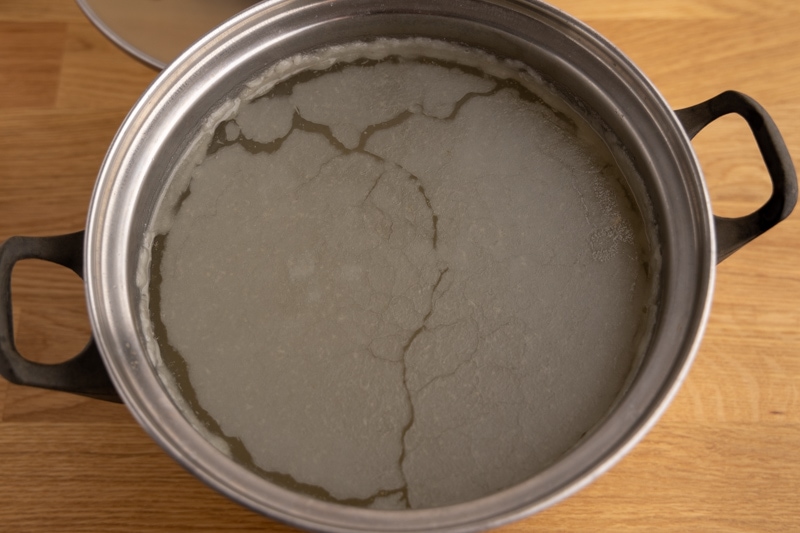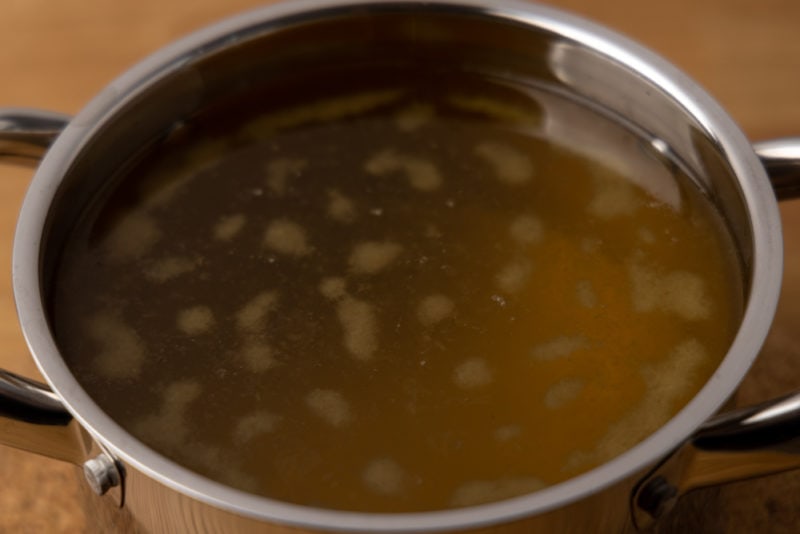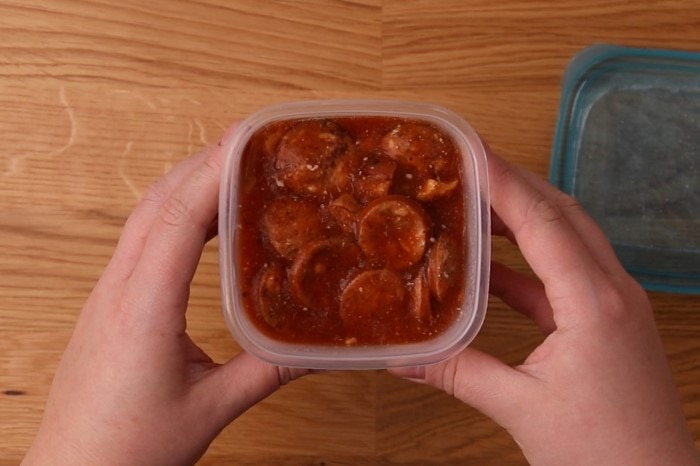How to Tell if Chicken Broth Is Bad? [4 Things to Check]
Here’s all you need to know about the spoilage of chicken broth. Learn what the signs of bad chicken broth are and what might be concerning but is actually okay.
So you’ve got some leftover chicken broth in the fridge, and you’re not sure if it’s still okay to eat. Or an old unopened can of chicken broth that looks iffy.
That makes you wonder: how to tell if chicken broth is bad?
Let’s dive right into the spoilage signs.

How to Tell if Chicken Broth Is Bad?
Your chicken broth is bad if it’s still unopened and the can is leaky, rusty, or swollen. If it’s opened, toss it if it smells off, tastes bad, or is open for longer than 4 days. Some brands allow for longer than four days of storage, and that’s okay too.
That’s the high-level overview of chicken broth spoilage.
Next, let’s get into the specifics.
Can Is Leaking, Rusting, or Swelling
If the box or can isn’t intact, say it’s leaky, swelling, or the can is rusty, the broth is unsafe.
None of those necessarily mean the broth is spoiled, but using it is risky. Because of that, it’s best to play it safe and toss it.
If you drop your can or box and it starts leaking (unlikely, but it might happen), treat it as an open container and use it within 3 to 4 days.
Off Smell
If your chicken broth smells sour, off, or “bad” in any other way, discard it.
From what I’ve found, a “funny” smell is the most common sign of an open broth that’s spoiled. You open the container or lift the lid, give the thing a good whiff, and it’s clear that something is wrong.
(That usually happens after more than a few days of storage, which we’ll cover in a minute.)
If the stock smells the way it usually does, which depends on the mix of herbs and aromatics used, it’s fine.

Open for More Than 3 – 4 Days
Leftover chicken broth stays safe for 3 to 4 days after opening or making. The same rule applies to all leftover perishable foods.
Does that mean that it’s going to be spoiled on day five? Not necessarily, but you never know, as it’s difficult to spot the first signs of spoilage.
(I sometimes keep my homemade chicken broth for up to 5 days, but never longer than that.)
That said, some brands might inform that theirs last for up to 7 days of opening. And if that’s what the label says, that’s the recommendation you should follow.
Or you can try to use it within four days to stay extra safe.
Fortunately, if you have more broth than you can handle within the mentioned four days, you can portion and freeze it. Frozen chicken broth retains quality well and is ready for use after defrosting it overnight in the fridge.
Bad Taste
If the container is intact, the broth smells okay, and it’s not opened for more than a couple of days, it’s most likely fine. But there’s one more thing you can do to check its quality: drink a sip or two to check its quality.
95 out of 100 times, the flavor will be okay, and the chicken broth will be fine to use. But if the taste seems off for any reason, it’s a sure sign the soup base is spoiled, and you should toss it.
Other than that, if there’s anything else about the broth that doesn’t seem quite right, trust your gut and assume it’s not safe to consume.
If your homemade broths go bad way too often, and you’re not interested in freezing them, consider switching to bouillon cubes. They aren’t the healthiest option out there, but at least you can quickly cook as much broth as you need when needed.
What’s Usually Okay
Now that we’ve covered the typical signs of spoilage, let’s talk about things that might seem a bit concerning to some but are perfectly okay.
White Layer of Fat on Top
Chicken broth, especially homemade, grows a layer of fat on top of the liquid after being refrigerated for a day or so. That fat should be creamy white, without any discolorations or mold.
That layer might be quite thin or pretty thick, depending on how much fat was in the chicken. If it’s chicken bone broth, expect a lot of fat. Otherwise, a thin layer is as much as you can get.
If you notice anything weird going on on the surface of the fat or the broth itself, discard it. Scooping the “spoiled” fat and using the rest is a bad idea.

Sediment And Cloudiness
Unless the label says otherwise, store-bought chicken broth should be clear and without any sediment on the bottom. That’s not the case for homemade broth.
If you cook your own broth and don’t filter it before storage using a cheesecloth or something similar, there will be some sediment on the bottom and possibly a bit of cloudiness. That’s perfectly normal and nothing to worry about.
(A fine mesh strainer still allows for quite a lot of particles to get through.)

Jello-Like Consistency
Chicken broth is a rich, but relatively thin liquid. Kind of like water with a bit (or a bunch, depending on whether it’s homemade or store-bought) of fat added.
But if you’re buying or making chicken bone broth, it might be thick and jello-like at low temperatures. That’s normal for bone broth, and it’s a good thing.
(If you’re after the collagen that’s trapped in the bones, a gel-like broth is a sign you extracted quite a lot of it. Good for you.)
Using after the “Expiration” Date
As you can read in my article on the shelf life of chicken broth, boxed and canned chicken broth is usually perfectly fine for at least a couple of months past the printed date.
(Read that article for details.)
So if yours is a month or three beyond its date, you can still use it if it doesn’t show any spoilage signs listed above.
Of course, if you’re uncomfortable using “expired” chicken broth, feel free to discard it. Better safe than sorry.
Rotten Records: Share Your Snap!
Caught some food past its prime? Upload your photo to “Rotten Records” and help others spot the signs of spoilage. Every image makes our food community safer and more informed!




![How Long Does Lentil Soup Last? [Shelf Life, Storage, Spoilage]](https://www.doesitgobad.com/wp-content/uploads/Lentil-soup-on-ladle-768x512.jpg)
